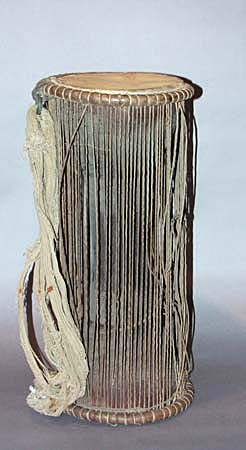
Owner: HWMC
Catalog#: AF-MBST-050-14
Provenance: Vichy-Encheres, France
Double-headed Drums
Dagomba 'Lunga' (A)
Northern Ghana
Dagomba
Wood, goat & bush antelope skin, cloth fiber, leather
Mid 20th Century
Length: 14.5 inches; Diameter: 7.5 inches
Membranophone – Struck (Directly) – Double-headed
A field collected ‘talking drum’ from the Dagomba of northern Ghana, called lunga (double-headed/waisted). This small lunga, shows signs of usage that was most likely used in local ceremonies such as accompanying puppets and dancers. There is some illegible script on one hide. The cylindrical rim portion of the drum on both ends are covered with goat skin and leather that is attached by hand-stitching. The ropes are made of bush antelope skin and they run between the drum head skins to keep them attached and to produce tension between them. The construction of the lunga itself is crucial to the drum’s ability to imitate language. The lunga is often played within an ensemble of two instruments, the lunga and the gungon. The gungon is like the brekete. The Dagomba have a smaller version of the brekete drum, called the gungon bla, displayed in this collection.
The double-headed hourglass drum from west Africa is made from a single block of wood. It is played with a curved stick and held under the armpit. The arm presses on strings which, by stretching the skins, modulate the sound. The construction of these drum in different cultures varies widely. This drum is called by several different names by the various west African ethnic groups. Some of the names are listed below:
Serer, Wolof, and Mandinka: tama or tamma
Yoruba: gangan or dundun
Dagomba: lunga
Akan (Fante, Twi, Baule) : dondo, odondo, donno
Dagbani, Gurunsi, Moore: lunna
Hausa: kalungu, kalangu, dan kar’bi
Bambara, Bozo, Dyula: tamanin
Songhai: doodo
Fulani: mbaggu, baggel
